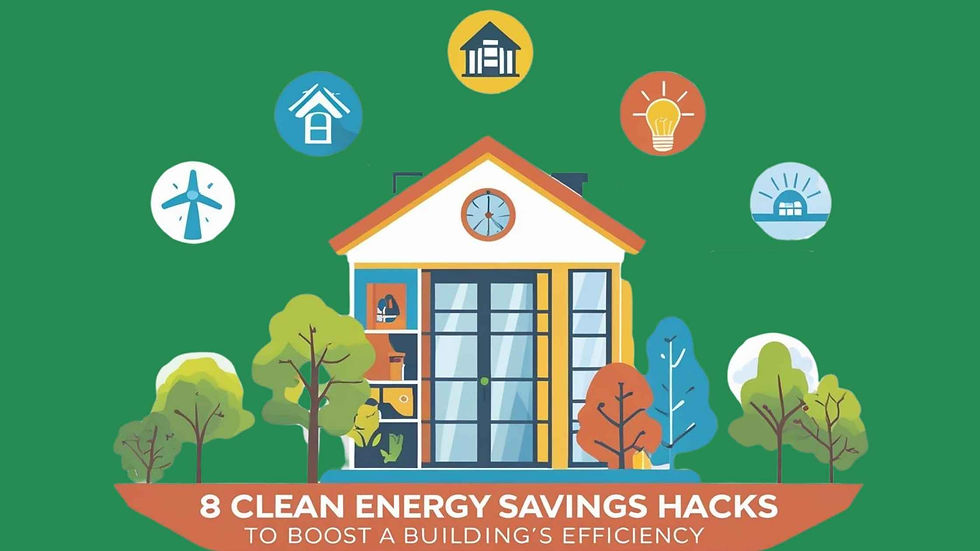8 Clean Energy Savings Hacks To Boost Your Building's Efficiency
- Trupti Doshi

- Aug 13, 2025
- 3 min read
Updated: Oct 28, 2025

Did you know? According to the International Finance Corporation (IFC), green buildings represent a $24.7 trillion investment opportunity by 2030 across emerging market cities. This explosive potential for clean energy savings proves that energy-efficient construction isn’t just a trend—it’s the future.
At Auroma Architecture, under the pioneering leadership of Architect Trupti Doshi, we believe that buildings should nourish, breathe, and evolve like living beings. Trupti Doshi’s acclaimed projects, such as the Sharanam Convention Centre and the Auroma French Villaments, demonstrate how sustainability can be seamlessly woven into aesthetics and functionality—creating spaces that respect both the Earth and the people who inhabit them.
Here are eight energy-saving hacks you can adopt—some are simple design choices, while others require transformative thinking. All of them are deeply inspired by Trupti’s architecture that champions harmony with nature.
1. Orient Buildings Like Living Organisms
Orientation is the soul of passive energy efficiency. In hot and humid zones like Pondicherry, buildings facing north and south can drastically reduce heat gain. This isn’t theory—it’s practice. Architect Trupti Doshi orients all major walls and window systems at optimal angles to harness breeze and daylight while avoiding excessive solar exposure. The result? Natural lighting, better ventilation, and massive clean energy savings from reduced artificial cooling and lighting.
2. Harness the Power of Courtyards and Breezeways
Courtyards aren't relics of the past—they’re bioclimatic marvels. In Trupti’s School for Integral Education, central courtyards and breezeways connect all spaces while enabling natural light and wind flow. The design encourages stack ventilation—hot air exits through high vents while cool air is pulled in through lower openings. This drastically reduces dependency on mechanical ventilation, contributing significantly to lower construction energy consumption.
3. Use Thermal Mass To Your Advantage
Heavy materials like compressed earth blocks, lime plasters, and rammed earth absorb heat during the day and release it slowly at night—balancing internal temperatures naturally. Trupti Doshi’s Sharanam Centre is an iconic example where such energy-saving building materials cut cooling costs and provide year-round comfort. In tropical climates, thermal mass is not just smart—it’s essential.
4. Elevate Roofing With Radiant Barriers
Roofs can be the biggest source of heat gain. At Auroma Architecture, we recommend roofing solutions that combine insulation with reflective radiant barriers. Vaulted or arched ceilings also increase air volume, helping hot air rise above the occupant level. Pair this with skylights and green roofs, and your building becomes a passive thermal machine that dramatically amplifies clean energy savings.
5. Switch To Breathable Walls
Conventional cement traps moisture and heat. Architect Trupti Doshi champions lime plasters and stabilized mud blocks that breathe—absorbing and releasing humidity, reducing mold risk, and enhancing indoor air quality. Breathable walls aren’t just a nod to tradition; they are modern climate tools that reduce reliance on dehumidifiers and air conditioners—an often-overlooked aspect of construction energy consumption.
6. Prioritize Lighting That Connects With Nature
Lighting isn’t just illumination—it’s emotion, productivity, and health. At Auroma Architecture, every space is designed to maximize daylight penetration without glare. Deep overhangs, louvred shutters, and skylights replace artificial lighting for most of the day. Projects like Heaven 360 Home illustrate how natural light becomes the primary source of visual comfort and contributes to deep clean energy savings.
7. Integrate Reclaimed and Local Materials
Locally sourced and reclaimed materials minimize transportation emissions and tap into the embedded wisdom of vernacular architecture. Architect Trupti Doshi uses reclaimed timber, fly ash bricks, terracotta jaalis, and lime from Tamil Nadu villages. These energy-saving building materials have lower embodied energy and higher soul value—offering authenticity, durability, and carbon-conscious construction.
8. Smart Water = Smart Energy
Every drop saved is energy saved. From rainwater harvesting to greywater reuse, water efficiency contributes significantly to reduced energy loads, especially in pumping and heating. Sharanam’s zero-discharge design collects, recycles, and reuses 100% of its water. Auroma’s residential projects use gravity-fed systems wherever possible—further minimizing construction energy consumption at both the building and community levels.
Why Settle for Less?
Every building can be a climate solution if designed with intent and care. If you’re building or renovating, now is the time to choose an architect who sees beyond the blueprint. Architect Trupti Doshi and her team at Auroma Architecture bring a rare blend of artistic sensitivity, scientific integrity, and ecological wisdom to every project.
Her spaces don’t just conserve energy—they celebrate life. If you haven’t experienced the magic of living in a climate-responsive home or working in an environment that energizes you instead of draining you, now is your moment.
Book a consultation with Architect Trupti Doshi today. Let us help you unlock the hidden intelligence of your space—and make clean energy savings a living reality.


.webp)








